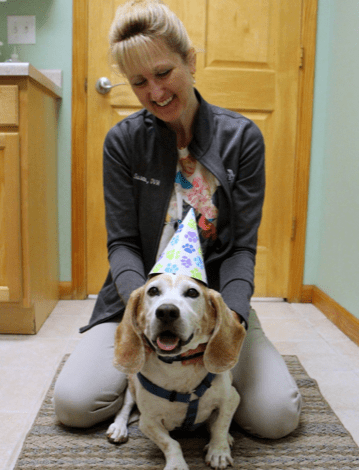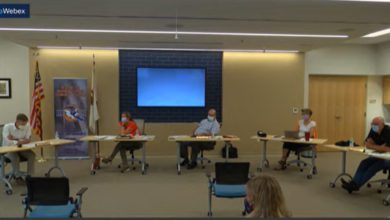Susan Hites is not your typical veterinarian: using chiropractic to treat family pet

By FRED KRONER
fred@mahometnews.com
It all started on a dairy farm in Wisconsin.
Or, maybe it didn’t.
As a child, Susan Hites developed a deep love for animals and can’t remember ever wanting to be anything except a veterinarian.
“I never wavered on this decision from first grade on,” said Hites, a Mahomet resident.
Summer trips to the out-of-state dairy farm from the family home in Grayslake, Illinois, had the potential to expose the youngster to farm animals, especially at milking time for the 150 Brown Swiss Cows.
Inside the barn is not where Hites developed her interest for a future profession, however.
“Unfortunately, I was too small to help with the milking,” Hites recalled, “so during milking time, I was given the task of getting cats out of the barn and taking them up the hill to the main house.
“As one can imagine, this was a never-ending task and kept me busy and out of the way.”
Hites isn’t certain she ever knew how many cats called the dairy home.
“I am suspicious that I moved the same cat a few times since it would run back down to the barn after being deposited at the house,” Hites said. “On the farm, we had so many cats that it was difficult to know an exact number.”
When she wasn’t hanging out with cats as a youth, Hites spent time with some dogs.
“Our neighbor in Grayslake, Dorothy Quinn, raised Golden Retrievers and always had a litter each summer,” Hites said. “I was tasked with being the puppy exerciser.
“Basically, I would get the pups used to being around people and other things in the environment. She had this beautiful garden that I would take the pups to and they would follow me around like a little parade.
“It was a magical garden. Mrs. Quinn always welcomed me coming to visit her crew, even when I came home to visit from college. She is a person that greatly influenced me.”
Is it any surprise where Hites elected to focus her professional endeavors?
“My dad was slightly miffed when I opted to work with small animals and not farm animals, but I told him he shouldn’t have made me play with the cats all the time,” Hites said.
***
Hites has a degree from the University of Illinois in agricultural science. In 1992, she graduated from the UI College of Veterinary Medicine.
Six years later, Hites started a journey which makes her unique among area veterinarians.
“I chose to stop working for other veterinarians once I started performing holistic modalities,” Hites said. “When I started practicing holistic medicine, I quickly realized that my employer would not be happy with this new way to practice.
“My appointments take much longer than a traditional veterinarian since I need to gather and go over more information.
“I also strive to move slower, allowing the animal time to get used to me. I need them to be relaxed and trust me.”
Acupuncture and chiropractic adjustments are only a part of the veterinarian services available through Hites.
“I offer integrative veterinary medicine, meaning that I work with the pet’s regular veterinarian to find the best path back to health or to maintain quality of life,” she said. “I discuss diet, supplements, herbs, chiropractic, acupuncture, cold laser, magnetic therapy, food therapy and even different things like collars, harnesses and foot pads to help patients.”
A quarter of a century ago, Hites couldn’t imagine doing the work she does today. Her opinion of chiropractic care was not favorable.
“I was a total non-believer in chiropractic because I had received a chiropractic adjustment a few years before and ended up requiring emergency surgery for a ruptured disc,” she said. “Thus, you can understand my hesitation.”
When she enrolled at a chiropractic school in 2000, she had ulterior motives.
“I actually told the founder of animal chiropractic that I thought they were quacks and just taking people’s money,” Hites said, “and I was there to prove chiro didn’t work.”
As the saying goes, ‘seeing is believing.’
“I performed chiro on a little Pomeranian that the owner found suddenly paralyzed in all four legs,” Hites said. “I was in the Western suburbs and we had no specialty clinics at that time.
“Her only option was U of I. The owner couldn’t afford this option and desperately wanted to know if anything else could be tried. I brought up chiro and – after my boss had her sign a waiver – I adjusted this dog’s neck. Shockingly, she could walk again.
“I think I was more shocked than the owner. The owner told everyone she knew and, alas, my chiropractic practice started.”
Hites has owned The Whole Pet, LLC. since 2003.
“I currently see patients at SportsVet Animal Medical Center in Savoy (and have the past 10 1/2 years) and at Kruger Animal Hospital in Bloomington (for the past six years),” she said.
Hites started her journey into holistic medicine in 1998, mainly out of a sense of frustration about not being able to help all of the patients that she would see.
“When I became a veterinarian, we had no pain meds for dogs,” Hites said. “We only had drugs used for horses to control pain from arthritis.
“These drugs often times caused severe stomach upset and sometimes even death in patients. Thus, I became very frustrated that we were having to euthanize older patients because we had nothing to control their pain, so I started researching different options.
“I found myself at an herbal conference – I was a total non-believer. I learned many things and while I was there, I also lost a good-hearted bet with fellow veterinarians.
“If I lost – which thankfully I did – I had to attend chiropractic school.”
A few months later, she found herself attending chiropractic school (Options for Animals) in a little town in western Illinois, Hillsdale.
“They were the only school in the world at the time (for animal chiropractic),” she said. “After four months of classes (students attended for five days a month and then went back to their regular practices and studied at night), I developed a relationship with another vet that did acupuncture, so she did that part if needed.
“Then when my family relocated to New Mexico, I found I needed to study acupuncture myself.”
***
The success stories are all that Hites needs to keep her motivated. There are many.
“The reason I continue to do this every day and for so many hours a week is easy,” Hites said. “The joy of seeing paralyzed patients that even the specialists said never would walk again; the joy on the owner’s face when their beloved pet is no longer in pain and can enjoy life again; the kisses and licks I get from my patients every day; the smiles on my patients’ faces; the dogs that come running into my exam room because they are excited for their treatment; being called ‘the treat doctor’ and ‘the doctor that makes the pain go away.’
“These are the reasons I do what I do. I get to help people maintain and strengthen their bond with their furry children every single day.”
Her work and accomplishments are possible because she took a leap of faith. She studied and researched a modality that she didn’t believe in and it ultimately changed the course of her work.
“I continue to perform these types of modalities for several reasons,” she said. “They work, they have their place and I want to make sure people have a reputable place to learn about alternative modalities so they know what these modalities can and cannot do.”
Now, one daunting task remains: convincing others in her profession that acupuncture and chiropractic care for animals are viable options for pet owners.
“The main challenge that I face is other veterinarians,” Hites said. “I have been called a quack many, many times, from local vets all the way to the university.
“All I ask of these veterinarians is that they become educated, instead of just telling clients these alternative modalities will not work or that they might hurt the patient, or that there is no research – which is very often not the case – that these vets learn where to refer a client who has questions, refer to an educated professional that offers these modalities.”
Hites is willing to be the leader of the bandwagon.




“I am always ready and willing to share my knowledge with others,” she said. “No, I can’t cure everything, but in most cases I can help with quality of life and sometimes, that is all owners are needing.
“I understand why other veterinarians are concerned – I was a non-believer myself – but I and most of my other colleagues that perform similar modalities have spent a great deal of time educating ourselves in these areas.
“In general, we are extremely well-versed in traditional medicine as well. We must know traditional medicine extremely well in order to make sure that the modalities we are using are not going to interfere with anything the regular vet is doing.”
Hites can appreciate the sentiments of those who are not supportive of what she offers. Not long ago, she was in the shoes of those non-believers.
“I truly do understand why people and other veterinarians doubt these modalities,” she said. “I try to explain to them that I was in the exact same boat, but once I learned how rigorously animal chiropractors are educated and tested on their knowledge and techniques, and then I saw it work with my own eyes, I had to become a believer.
“I always stress to them that we are not only taught how to manipulate but also when NOT to manipulate. I merely want them to educate themselves so that they have a qualified person to refer clients to that ask, so that the client doesn’t end up seeking out an unqualified person.”
There are times that Hites must send a client to another source.
“I certainly do not practice all available modalities, so I have to refer people to others when needed,” she said, “or I have to call another vet to ask questions.
“I think the biggest hurdle that many people face and must overcome in order to grow is to admit that they don’t know everything. They just need to know others that they can ask.”
She is heartened by the growing number of success stories.
“I have had two patients since March that had been sent to the University of Illinois by their regular vet due to paralysis,” Hites said, “and the U of I told the owners that their pet was too far gone – not enough feeling left – and that even surgery would not bring them back to walking, that the only option was a wheelchair or euthanasia.”
Hites didn’t believe either of those options were acceptable and willingly intervened.
“The owners sought me out on their own,” Hites said. “Both patients are now walking (though not 100 percent normally), and have control of bladder and bowel.
“The patients are pain free and happy, as are their owners.”
There’s literally no end to her list:
— “A patient with such severe arthritis that the owner is considering euthanasia because their pet can’t take certain meds and thought there were no other options, now has a great quality of life,” Hites said.
— “A service animal that was no longer able to perform her duties because of pain post-surgery for a knee issue, can now work again pain-free,” she added.
How often Hites sees the patients is based on the needs.
“It totally depends on what the issue is,” she said. “If totally paralyzed, at least one or two times a week until progress, then we decrease.
“If OA (osteoarthritis), usually recheck in two to three weeks so we can evaluate. Some of my patients only come in for an adjustment every eight weeks. That is all they currently need for maintenance.”
***
Veterinarians, in general, face an obstacle not common for people doctors. The patients seen by vets can not verbalize their problem or communicate through words.
“My patients cannot talk in the traditional sense, but through careful questioning and listening to their owners, I can glean much useful information,” Hites said. “This is again why my appointments take longer.
“I ask a lot of questions and ask for a lot of information. I truly enjoy figuring out why a patient is acting a certain way or can no longer perform a certain activity.
“It’s like being a detective. Between a physical exam, the clinical signs the owner shares, and any test results that the regular vet has done such as radiographs and bloodwork, I may be able to come to an exact definitive diagnosis.”
There are times that outcome is impossible.
“Sometimes my patients have sought me out because they cannot afford advanced diagnostics, such as an MRI, or the patient cannot undergo the anesthesia in order to get the advanced diagnostics,” Hites said, “so in some cases we do not have a definitive diagnosis.
“In these cases, I discuss what we know for sure, can we palpate certain things, and radiographs can show certain things, as well as what we don’t know for sure.
“Then I give the owner options of how to proceed – continue traditional care, seek a specialist or add a complementary modality.”
The vast majority of Hites’ patients are dogs, about 85 percent, she estimates.
“I work with both dogs and cats,” she said. “My canine patients include sporting dogs (agility, flyball, lure coursing, oval racing, dock diving, nose work), show dogs, hunting dogs, service dogs, police dogs, military dogs and, of course, pets.
“I work with young, old, and in between,” Hites said. “I help dogs that get injured performing the sport they love or the duty they perform as well as helping dogs stay in shape for their activities.
“I have a few show dogs that just were not winning despite their pedigree. After having chiropractic care, they started winning. I work with pets that are starting to slow down with age.
“Often times they are starting to develop osteoarthritis. Chiropractic certainly will not cure OA, but it definitely helps decrease pain, increases ability to move and increases quality of life. OA is an incurable inflammatory disease, so our goal is to control the inflammation and decrease the rate of progression, so chiro is just part of their treatment plan.
“Older cats often start having difficulty jumping and doing stairs. This can greatly affect their quality of life. I use different modalities to help them as well.”
***
Persons interested in seeking Hites’ services can reach her by text at 217-722-8367 or they can email her at smhites@thewholepet.com.
She tries her best to see the patients in pain or who are paralyzed as quickly as possible.
“I try to get others in within a week or so,” she said. “Sometimes, due to the owner’s schedule (they cannot come in when Hites has openings) it can take several weeks.”
Hites has never done any advertising.
“I feel that patients find me when they need me,” she said. “There are a few other veterinarians in the area that perform acupuncture, but what makes me unusual is that I can utilize chiropractic as well when appropriate.
“As far as I know, there is only one other veterinarian in central Illinois that performs both modalities. I feel that chiropractic allows acupuncture to work better. It makes perfect sense to me, chiropractic is purely mechanical, like moving cars off the nerve highway so that acupuncture can stimulate the flow of traffic (nerve impulses).”
Hites understands what’s at stake when she is contacted.
“Often my patients have gone to several different vets before coming to me and I am their last chance,” she said. “I need to get it right the first time.
“I do work closely with all the veterinarians at my two practices as well as all the referring veterinarians. I rely on the traditional vets to run blood work, take radiographs and dispense medication.
“I work with the pet’s regular veterinarian. I do not replace them. I call what I do integrative veterinary medicine. I work with the regular vet and add other modalities that can help achieve the best quality of life for each patient. Figuring out what is going on with an animal and how to best help them is what I love doing every day.”
The demand for her services is strong.
“People are seeking other modalities for their pets, just like they want for themselves,” Hites said. “Some patients cannot tolerate certain medications, have organ dysfunction that does not allow a certain medication to be used, or cannot undergo surgery due to organ dysfunction or cost.”
Because she works with a family’s existing vet, Hites views her treatments as a win-win all the way around.
“The pets remain healthier for longer, thus will continue to be their patients for longer, and the owners get a healthier pet,” she said.
***
Away from work, Hites is still surrounded by animals.
She is a proud pet owner.
“Currently I have a 17-year-old cat, Jasper, an 8-year-old cat, Beau, and a 6-year-old cat Chester,” she said. “I recently lost my 16-year-old Beagle, Gilley.
“In general, my pets find me, they usually show up at the clinic or my house and need a home.”
Hites and her husband of 28 years have two children: a 22-year-old son who is studying computer science in engineering at Southern Methodist University (SMU) and a 19-year-old daughter studying biomedical engineering at SMU.
Her husband is a mechanical and aerospace engineer. He is a professor and chief information officer at SMU.
As Hites reflects on her career, she sees an irony in her profession of choice.
“When I was growing up, women mostly became housewives, secretaries or teachers,” Hites said. “Since I had an aversion to wearing pantyhose and dresses, my only option was a gym teacher. So of course, I chose to be a veterinarian.”
And now?
“Women have become the majority of the veterinarian work force,” she said.




